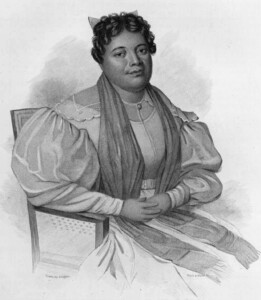Thank you, once again, for giving me this opportunity to share the history of Kekāuluohi. I appreciate all of the comments and questions that were posed and have provided some answers below. In a few cases I have combined questions since they were interrelated. In addition, many asked if the presentation or slides would be available via the recording. You can find the video recording above. Please feel free to contact me at sbuchana@hawaii.edu if there is additional information I can provide for you.
Q: What kind of rights, autonomy, did women who were not in the ali‘i class have during this time? Can you speak about the cultural and/other background for the power of the Hawaiian women, and any changes since the 1800s? In this 100th year, when did women first vote in Hawai’i?
I often get asked these questions when presenting information about the aliʻi women and there are multiple answers. The first thing I would point out is that Hawaiian governance was different from American or European governance. There was a greater stress on balance of power and one book that gives insight into Hawaiian governance is Dr. Noelani Arista’s new book, The Kingdom and the Republic: Sovereign Hawaiʻi and the Early United States (Philadelphia: University of Pennsylvania Press, 2019).
Certainly the aliʻi women had power that was incomparable to anything in the “western” world. For those women who were not of aliʻi status – the makaʻāinana or “commoners” – they, too had status within their local families and regions. But the concept of the “vote” by western standards is perhaps too narrow to apply to Hawaiʻi in the nineteenth century. We know that aliʻi women in the legislature certainly carried on their right to “vote” or create and implement legislation. Women who were not aliʻi could appeal to the government directly as is evidenced by petitions.
With the restructuring of government through the Bayonet Constitution of 1887 and succeeding events, including the overthrow of the Hawaiian government followed by annexation, women seemed to lose their traditional voice in government, but even this is debatable. The “vote,” by western standards, was not restored until 1920, but we must remember that the vote was also tied to who was recognized as a “citizen” in Hawaiʻi and this complicates matters further. Please see, also, the articles by Lauren Basson and Patricia Grimshaw listed in the selected bibliography below.
Q: Did the tradition of powerful women in Hawaii continue after 1898?
Following up on the answers above, the answer to this question is a resounding “YES”! As I noted in the presentation, the powerful connections of the kuhina nui in the mid-nineteenth century seemed to be carried on by aliʻi women in the latter half of the nineteenth century. The most influential Hawaiian matriarchs of the late 19th century — Bernice Pauahi Bishop, Queen Emma, Queen Kapi’olani, and Queen Lili’uokalani – perhaps made decisions to create land trusts as an approach modeled by the alliances of kuhina nui before them. All of these women created their trusts in perpetuity and they continue to have an impact on Hawaiʻi today.
Q: What was the date of Kekauluohi’s death and her age at the time?
She died on June 7, 1845. Most sources indicate that Kekāuluohi was 50 or 51 at the age of her death.
Q: Regarding the people’s petitions sent to the king to block land sale to foreigners, from which island was most resistance noted?
Petitions came from different islands and they are available to view at the Hawaiʻi State Archives. However, I am not sure if this includes all of the petitions from the time. Still, the petitions do reveal the direct requests of the people of the islands – the makaʻāinana – and it seems a fairly widespread and consistent request.
Q: I was surprised that Kekāuluohi was 41 when she gave birth. Was that the first time she became pregnant or had she had miscarriages in her first 2 marriages?
I, too, was surprised to find out that Kekāuluohi had a child at 41. I am not sure if she was ever pregnant before and there does not seem to be descriptions of a prior pregnancy or miscarriage. I am not sure if this information would even have been shared or recorded. However, I also believe that there are sources about her life we have yet to find and translate. Perhaps further investigation and translation of Hawaiian language newspapers and documents might give us additional insight into this aspect of her life.
: I believe she was buried at Pohukaina, but was not moved to Mauna Ala. Where is she?
This is an intriguing question. One source indicates that Kekāuluohiʻs remains were left at the royal tomb at Pohukaina, but later removed elsewhere, but it is unclear. I have not done research on this aspect of her life and death, but I suspect that there may be further information about her in Hawaiian language documents that have yet to be transcribed and / or translated.
Selected Bibliography:
Arista, Noelani. The Kingdom and the Republic: Sovereign Hawaiʻi and the Early United States.
Philadelphia: University of Pennsylvania Press, 2019.
Basson, Lauren L. “Fit for Annexation but Unfit to Vote? Debating Hawaiian Suffrage Qualifications at the Turn of the Twentieth Century.” Social Science History, 29.4 (Winter, 2005): 575-598.
Boston Recorder, April 29, 1842.
Corley, J. Susan and M. Puakea Nogelmeier, “Kalanimoku’s Lost Letter,” Hawaiian Journal of History, Volume 44 (2010): 91 -100.
Grimshaw, Patricia. “Settler Anxieties, Indigenous Peoples, and Women’s Suffrage in the Colonies of Australia, New Zealand, and Hawaiʻi, 1888 – 1902.” Pacific Historical Review, 69.4, Woman Suffrage: The View from the Pacific (Nov., 2000): 553 -572.
Johnson, Donald D. “The ʻWily Savageʻ: A Tale of Kamehamehaʻs Time,” Hawaiian Journal of
History, Volume 13 (1979): 17-18.
Ka Nonanona, Honolulu, December 4, 1842.
Ka Nupepa Kuokoa, Honolulu, Aug. 15, 1868 to September 26, 1868.
Kamakau, Samuel M. Ruling Chiefs of Hawaii. Translation by Mary Kawena Pukui. Honolulu: Kamehameha Schools Press, 1961.
Kameʻeleihiwa, Lilikalā. Native Land and Foreign Desires: How Shall We Live in Harmony? Ko Hawai’i ʻĀina a me Nā Koi Pu’umake a ka Po’e Haole: Pehea lā e Pono ai? Honolulu: Bishop Museum Press, 1992.
Kameʻeleihiwa, Lilikalā. Nā Wāhine Kapu. Divine Hawaiian Women. Honolulu: Na Mea Hawaiʻi, 2016.
“Ke Kumukānāwai o Ko Hawaiʻi Pae ʻĀina (MH 1840), Constitution of Hawaiʻi (1840),” in Constitutional Documents of the United States of America, 1776-1860, Supplement: Hawaiʻi and Liberia, edited by Robert Stauffer and D. Elwood Dunn (K.G. Saur, 2008): 29-41.
Mookini, Esther T. “Keōpuōlani, Sacred Wife, Queen Mother, 1778-1823,” Hawaiian Journal of History 32 (1998): 1-24.
Peterson, Barbara Bennett, ed., Notable Women of Hawaii. Honolulu: University of Hawaiʻi Press, 1984.
“Petition to Kaʻahumanu III from the people of Kailua,” June 12, 1845. Hawaiʻi State Archives, Foreign Office and Executive Records, 1790-1900, Box 402-13-316 Chronological File 1790-1845, 1845: Jun. 12, 13, 14. Translation by Shirley E. Buchanan.
“Petition from the people of Kona, Hawaii. To Kamehameha III and the Legislature,” Kailua, June 25, 1845. Hawai’i State Archives, General Records of the Legislature, 222-2-3: Leg. 1845 Petitions. Archival translation.
Poulson’s American Daily Advertiser, Philadelphia, Feb. 13, 1817.
“Proclamation re: Kekauluohi signed by Kamehameha III,” June 8, 1839. Hawaiʻi State Archives, Foreign Office and Executive Records, 1790-1900, Box 402-5-101 Chronological File 1790-1845, 1839: June.
Richards, William. Memoir of Keopuolani, Late Queen of the Sandwich Islands. Boston: Crocker & Brewster, 1825.
Silverman, Jane L. Kaahumanu: Molder of Change. Honolulu: Friends of the Judiciary History Center of Hawaii, 1987.
Stokes, John F. G. “Burial of King Keawe,” Papers of the Hawaiian Historical Society, No. 17
(Honolulu: Hawaiian Historical Society, The Printshop Co., Ltd., 1930): 63–72.
Taylor, Albert Pierce. Under Hawaiian Skies: A Narrative of the Romance, Adventure and History of the Hawaiian Islands. Honolulu: Advertiser Publishing Company, 1923.
Wilkes, Charles. Narrative of the United States Exploring Expedition During the Years 1838, 1839, 1840, 1841, 1842. London: Wiley and Putnam, 1845.



